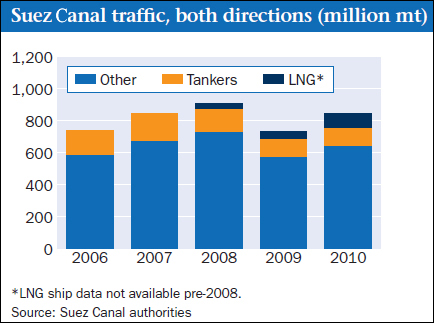Piracy: An Escalating Threat to Shipping?
Piracy threat to tanker trade
When Egypt descended into revolutionary chaos in February an immediate source of concern for energy markets was the potential closure of the Suez Canal, a key artery for shipping between the Atlantic and Pacific basins.
Many analysts noted that the number of oil tankers using the canal was already on the decline. Tanker traffic had fallen, but mainly as a result of the global economic downturn of 2009.
It recovered slightly in 2010. However, a secondary threat to Canal traffic has been the rise of piracy off the Somali coast and in the Gulf of Aden, which is having a clear effect on regional shipping.
In 2010, the net tonnage that passed through the Canal in both directions amounted to 846,389,000 tons, of which tankers made up 113,672,000 tons and LNG ships 91,040,000 tons.
This compares with a high in 2008 of 910,059,000 tons, of which tankers made up 146,658,000 tons and LNG ships 38,987,000 tons.
So while there has been a clear drop in tankers transiting the Canal, the number of LNG ships has in fact risen sharply, owing to increased liquefaction capacity in Qatar and Yemen.
It is hard to disentangle the twin impacts of economic downturn and piracy. However, the drop in tanker traffic is likely to reflect more the former than the latter.
In April 2008, OPEC’s Middle Eastern members were pumping 21.39 million b/d of crude, but a year later output had fallen to 19.22 million b/d. By December 2010, volumes had only risen back to 19.9 million b/d.
Suez Canal tanker traffic has changed in line with Middle Eastern crude output, whereas LNG shipments do not appear to have been deterred at all. Notably, while crude tankers have been hijacked, LNG ships have been relatively immune.
According to the International Maritime Bureau’s Piracy Report for 2010 only one LNG carrier was attacked in 2009 and one in 2010. (See related table: Attacks on ships by type, 2006-2010).
By contrast, there were 43 attacks on crude tankers in 2010, 96 on chemical and oil product tankers and 7 attacks on LPG ships.
Crude tankers have also returned the highest ransoms. However, regional data does reveal the impact of piracy: there has been a total collapse and lack of recovery since 2008 of tonnage passing through the Canal that originates from East Africa itself. (See related chart: Location of pirate attacks in 2010).
In 2008, this south-north trade accounted for 12,066,000 tons; in 2009 1,027,000 tons and in 2010 just 424,000 tons.
The same goes for Australian origin tonnage through the Canal, which dropped precipitously from 35,279,000 tons in 2008 to 2,225,000 in 2009, recovering only marginally in 2010 to 3,679,000 tons.
These regional drops in trade are far larger than can be accounted for by the global downturn.
For Australia, the decline reflects the fact that the saving made using the Canal versus the Cape of Good to access the Atlantic basin is relatively small.
The increased costs of shipping through the Gulf of Aden have outweighed the cost benefit of using the Canal. As the risks and costs of using the Canal rise, more ships from other regions are likely to re-route. (See related table: Total costs of maritime piracy, 2010).
There has also been a strong increase in tonnage destined for and originating from the Red Sea that transits the canal -- even in 2009 when total volumes dropped – suggesting increased use of land routes where possible to avoid danger areas.
To subscribe or visit go to: http://www.platts.com
![]()
